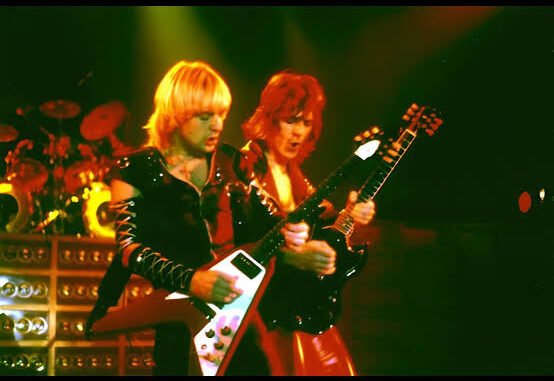
K.K. Downing & Glenn Tipton: Six-String Powerhouses of Judas Priest’s 1986 Fuel for Life Tour.
In 1986, Judas Priest embarked on what would become one of the most electrifying and visually groundbreaking tours in metal history: the Fuel for Life tour. This epic trek supported their futuristic, synth-laced album Turbo, and at the heart of its explosive performances were the band’s iconic twin guitarists — K.K. Downing and Glenn Tipton. By this time, Downing and Tipton had already forged a reputation as one of the most formidable guitar duos in rock. On the Fuel for Life tour, they didn’t just uphold that legacy — they amplified it to full throttle.
The Fuel for Life tour was not just another concert series — it was a spectacle. With neon lights, robotic aesthetics, and motorbikes roaring across the stage, Judas Priest embraced the glam-infused, futuristic vibe of the mid-80s without abandoning their heavy metal roots. And at the center of it all, Downing and Tipton brought the fire. Their synchronized guitar work, laser-focused solos, and charismatic stage presence were essential in giving the tour its legendary reputation.
K.K. Downing, with his Flying V guitar and wild blond hair, embodied the aggressive, raw edge of Priest’s sound. Known for his whammy-bar dives, gritty riffing, and no-holds-barred energy, Downing provided the attitude. On the other side of the stage, Glenn Tipton delivered precision and melody. Often favoring complex scales and classically influenced runs, Tipton’s solos offered technical finesse and clarity, perfectly complementing Downing’s chaos. Together, they crafted a sonic wall that was both brutal and beautiful.
During the Fuel for Life shows, tracks like “Turbo Lover,” “Locked In,” and “Out in the Cold” featured Tipton and Downing playing off each other with masterful chemistry. The new songs from Turbo required a slightly different tone and technique, with the band incorporating guitar synths to match the album’s futuristic sheen. Tipton embraced this new direction enthusiastically, exploring layered, digital textures in his solos. Downing, while more traditionalist in tone, adapted brilliantly, ensuring that even with synths in the mix, the essence of heavy metal still roared through every note.
Of course, the setlist wasn’t limited to Turbo material. Priest delivered fan favorites like “Breaking the Law,” “Metal Gods,” “The Sentinel,” and the explosive “Hell Bent for Leather.” In these classics, Downing and Tipton unleashed their vintage magic. Songs like “Victim of Changes” saw the duo stretching out into longer solos and instrumental duels, giving fans a taste of their virtuosic interplay. The way they traded licks and harmonized riffs showed not just technical skill, but deep musical intuition.
Beyond their playing, Downing and Tipton were captivating performers. On the Fuel for Life stage, outfitted with giant metallic props and pulsating lights, they commanded attention. Whether it was Downing leaning over the edge of the stage, axe in hand like a knight wielding a sword, or Tipton pacing deliberately with laser focus, every movement was calculated for maximum impact. They weren’t just playing guitar — they were telling stories with their instruments.
A key moment that encapsulates their magic came during the performance of “Electric Eye.” The blinding strobes, the pulsing intro, and the intertwining guitar lines created a moment of pure metal theater. It was futuristic, fierce, and flawlessly executed. Similarly, “Heading Out to the Highway” gave them room to stretch their melodic chops, proving that Priest’s twin-guitar attack wasn’t just about speed and aggression — it was also about soul and melody.
The Fuel for Life tour also left a lasting legacy in the form of Priest…Live!, the 1987 live album and concert video that captured many of the tour’s most memorable performances. The recordings are a time capsule of the band at their most ambitious — Tipton and Downing at the height of their powers, navigating flashy new material and beloved classics with equal confidence.
Behind the scenes, the partnership between Tipton and Downing was not without tension — creative differences and clashing personalities simmered for years — but on stage in 1986, they were locked in like never before. Their contrasting styles, far from being a drawback, created the dynamic sound that helped define Judas Priest’s identity.
In retrospect, the Fuel for Life tour marked the end of an era in some ways. It was the last tour before the band pivoted back toward a heavier, more stripped-down sound with Ram It Down and then Painkiller. But in 1986, Priest was chasing the future — and Downing and Tipton were riding the front lines with guitars blazing.
Looking back, K.K. Downing and Glenn Tipton’s performance on the Fuel for Life tour stands as a testament to what makes Judas Priest legendary: raw power, intricate musicianship, and the magic of two guitarists whose chemistry could set arenas ablaze. For fans of heavy metal, those nights in 1986 remain sacred — when the lights went down, the lasers lit up, and the sound of twin guitars tore through the air li
ke fuel for the soul.
Leave a Reply